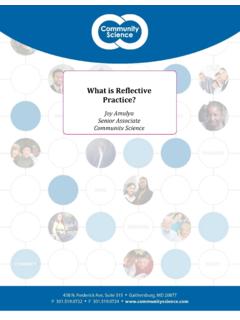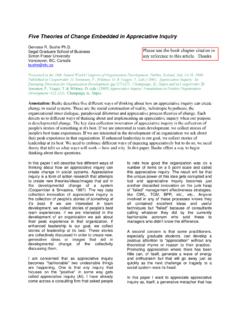Transcription of Scope, Scale, and Sustainability: What It Takes to …
1 Scope, scale , and sustainability : what It Takes to create Lasting Community Changedoi: R. Trent, , NeighborWorks America, and David M. Chavis, , Community Science96 THE FoundationReviewIntroductionComprehensiv e community initiatives (CCIs) refer to a diverse range of multifaceted initiatives that are funded by public sector agencies and philanthropies and seek to address complex social problems. Although CCIs target multiple policy arenas, employ different strategies and organiza-tional structures, and include varying collections of stakeholders, there are a number of features that help to define the contours of this approach to community change (Kubisch et al., 2002). These features include:Comprehensive strategies and programs that seek to address the multiple causes of social problems;Participatory and collaborative approaches to the planning and implementation of the initia-tive that involve diverse groups of stakeholders;Governance structures based at the neighbor- hood or community level designed to support collaboration across sectors;Systemic approaches to reform that influence how resources are distributed and used; and Technical assistance and other capacity-build- ing supports to sustain the community s long-term ability to improve a study for the Annie E.
2 Casey Foundation, we examined a group of CCIs to determine how these bold initiatives dealt with the challenges of achieving a comprehensive scope, taking pro-grams and strategies to scale , and sustaining their work after the end of a demonstration period. Eleven CCIs were selected based on how well they fit the general characteristics of a CCI in terms of integrating community development and human service strategies, working across sectors, fostering community engagement, and strength-Key Points This article examines success factors that relate specifically to the ability of a comprehensive community initiative (CCI) to achieve the scope and scale required to generate community-level outcomes and to sustain those positive impacts over time. The CCIs selected for study represent a wide range of goals, strategies, and organizational structures.
3 Six factors were found to cut across scope, scale , and sustainability . These factors include having a single broker or entity that holds the vision of the change effort; clearly defined roles; alignment among interventions, resources, and geography; meaningful community engagement; competent leadership and staff; and strategic, cross-level relationships. Additional factors were found to relate to suc-cess in achieving scope, scale , or sustainability individually. Lessons include to plan, operate, and evaluate based on a systems- and community- change framework; choose focused and affordable strate-gies; build the capacity to use data; and plan for change and conflict. Scope, scale , and SustainabilityWinter 2009 Vol 1:1 97ening networks (Ramsey, 2001). In addition, the CCIs included were, for the most part, sponsored by a major foundation, represented a long-term investment (at least six years), and were well-documented in terms of program and evaluation reports.
4 The CCIs included in this discussion are listed in Table looked at how well the selected CCIs achieved scope, scale , and sustainability , and examined the implications of this experience for the next gener-ation of CCIs. The research methodology included interviews with key staff who directly participated in the initiatives, analysis of interim and summa-tive evaluation reports, and review of the second-ary literature pertaining to the field in general. The goal of the research was to identify concrete examples of successful practices and strategies from which to extrapolate more general principles about promising practices for the design and implementation of CCIs. A number of factors in-fluenced all three dimensions of scope, scale , and sustainability , whereas others were more directly related to a single dimension (see Table 2).
5 Cross-Cutting Factors Certain factors cut across all three dimensions, allowing CCIs to achieve scope, scale , and sus-Name of Initiative Sponsoring funder(s)Geographic focusDemonstration periodCleveland Community Building Initiative Cleveland Foundation and Rockefeller FoundationCleveland, Ohio1993 2000 Comprehensive Community Revitalization ProgramSurdna FoundationSouth Bronx, 1998 Health Improvement InitiativeThe California Wellness FoundationNine communities in California1996 2001 Homeless Families ProgramRobert Wood Johnson Foundation and the US Department of Housing and Urban DevelopmentNine cities throughout the United States1990 1995 Local Investment CommissionMissouri Department of Social ServicesKansas City, presentNeighborhood Improvement InitiativeWilliam and Flora Hewlett FoundationSan Francisco, Calif.
6 (Bay Area)1996 2005 Neighborhood and Family InitiativeFord FoundationFour neighborhoods (one each in Detroit, Mich.; Hartford, Conn.; Memphis, Tenn.; and Milwaukee, Wis.)1990 1998 Neighborhood Partners InitiativeEdna McConnell Clark Foundation5 neighborhoods in New York City1996 2003 Neighborhood Preservation InitiativeThe Pew Charitable Trusts10 neighborhoods in nine cities around the United States1993 1997 Urban Health InitiativeRobert Wood Johnson FoundationBaltimore, Md.; Detroit, Mich.; Oakland, Calif.; Philadelphia, Pa.; and Richmond, 2005 TABLE 1 Initiative ProfilesTrent and Chavis98 THE FoundationReviewtainability. These factors shape a CCI s ability to develop and sustain a clear vision, execute well, and adapt and problem-solve Single Broker and Keeper of the VisionSuccessful CCIs had a single individual, in-termediary organization, or governance body responsible for keeping the initiative on track and making sure the capacity was there to take on the goals of the initiative.
7 Most importantly, the intermediary had a clear vision that was in alignment with that of the sponsoring entity of what success would look like, and that vision was maintained throughout guiding, supporting, and challenging the local sites. The intermediary kept the sites focused on the mission, ensured alignment and fit, and facilitated entrepreneurial responses to both challenges and opportuni-ties. Successful initiatives also had an effective broker that was able to connect sites to the right expertise and resources, bring the right people to the table, and troubleshoot to overcome bar-riers and resistance. These brokers were instru-mental in building trust within and among sites, as well as between sites and sponsoring entities, through fidelity to the mission and vision, de-livering results, maintaining high expectations, and insisting on high performance.
8 The honest broker was sometimes an individual ( , the executive director of the Comprehensive Com-munity Revitalization Program), an intermedi-ary organization ( , the national program office for the Urban Health Initiative), or the governance entity ( , the Local Investment Commission). Initiatives with a single individual or institution that served as an advocate and broker for the community, as well as tended to the needs and expectations of the funder, were most successful in equalizing power and build-ing true , Well-Defined Roles and ResponsibilitiesFoundations or other sponsoring entities must establish a clear framework and set of expecta-Cross-Cutting FactorsScope FactorsScale FactorsSustainability FactorsA single entity acting as broker and keeper of the visionIntegrated strategies that connect the dots Clear articulation and measurement of desired community change resultsCommunity ownership of the initiative from the startClear.
9 Well-defined roles and responsibilitiesEffective planning and evaluationIntentional focus on creating the capacity for scaleBuilding and sustaining the capacity of institutions rather than programsAlignment between goals, strategies, institutional interests, resources, and geographyFlexible funding to respond to a changing community contextUse of data to drive the initiative and influence policy changeLong-term sustainable fundingMeaningful community engagementCompetent leadership and the right staff capacityStrategic connections between the community and the public sector (city, state, and federal)TABLE 2 Success FactorsScope, scale , and SustainabilityWinter 2009 Vol 1:1 99tions to accompany their investment, while also allowing for local autonomy. Initiatives in which the funding entity set a clear strategic direction for grantees, but gave them the flexibility to chart their own course for achieving initiative goals, were more successful than initiatives in which the funder played a more active, micromanaging role.
10 In the latter case, the intermediary was usually hand-tied and unable to serve as an effective broker or coach. Without clear and distinct roles and responsibilities, these initiatives floundered in the process, with endless shifts in direction and lack of about roles and lines of accountability derailed a number of CCIs. Even when roles and responsibilities are clearly defined upfront, this is-sue must be revisited periodically throughout the initiative to ensure that definitions remain clear and continue to best serve the needs of the initia-tive. For example, reflections published by the Community Foundation of Silicon Valley, which served as a managing partner in the Neighbor-hood Improvement Initiative, noted that many of the stumbling points in the initiative stemmed from lack of clarity and unspoken assumptions about roles and responsibilities (Community Foundation of Silicon Valley, 2005).











